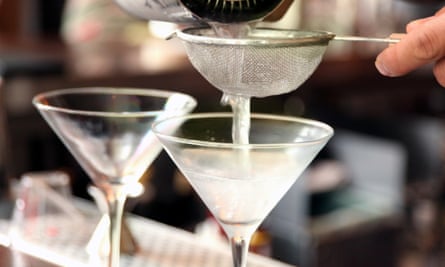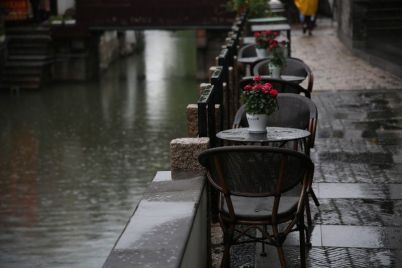The simple cocktail is above all the drink of nostalgia – for a time before we felt judged, hopeless and tired
This year, the martini was inescapable, the chosen lubricant for the age of retro pastiche – a moment governed by e-commerce aesthetes, for whom Mad Men is less a meditation on desire than a brochure for mid-century credenzas.
Gen Z flocked to geriatric hotel bars resurrected by TikTok and selfied their cheese-stuffed olives. The espresso version kept ageing millennials awake past their bedtime, helping recapture the jouissance of their 20s, if only for an hour. Rivers of gin flecked with vermouth flowed from the world’s cosmopolitan centers out to its hinterlands. In April, a New York Magazine piece declared a martini “boom”, with bartenders agog at just how many their customers were pounding. A high-end beverage consultant I spoke with said private clients had been asking for “martini-only parties”. In November, the CGA cocktail tracker, which measures the most popular cocktails in the US, saw the martini soar into third place, leapfrogging the once popular Manhattan. The espresso martini also rose five places in the rankings, the biggest jump of any cocktail.
On a recent trip to Las Vegas, where the Rat Pack’s boozy sophistication has long since been supplanted by bachelorettes sloshing three-foot-tall souvenir mugs in the shape of saxophones, I enjoyed a “marthatini” at Martha Stewart’s new restaurant, shaken tableside for maximal drama. At a kitschy diner, I watched a woman order a dirty vodka martini with extra olives, then request a shot of Hennessy in it. The color was sewage-like; she downed it with an admirable lack of wincing. That the martini, with all its minimalist pretension, had so thoroughly penetrated the least minimal or pretentious of American playgrounds seemed incontrovertible proof of its pre-eminence.
So what is behind the prohibition-era cocktail’s sustained revival?
With its restrained composition – only two ingredients (three if you include temperature: very cold) – the martini has always been shorthand for a sort of intellectual hedonism, increasingly in vogue among marketing managers who prefer the term experience curators.
Consider the shape.
The typical martini glass, with its long stem and angular vessel, derives its elegance not from the power of its curves but the svelteness of its geometry, a rejection of the Kardashian ass in glass form. To carry one aloft across a crowded bar requires the poise of a ballerina, the focus of a chess player. Not the laborer’s brawn or the Stem major’s rote memorization, no – balancing a martini glass falls higher on Maslow’s pyramid, a performance of nonchalance in the face of danger that displays worldliness and charm. And when you sip from its conical chalice, almost vulgar in its width, the volume is so concentrated towards the top you can down a good portion of its contents and it still appears brimming. A glass perpetually half full.
It is the drink of possibility, spanning modern gender divisions. For every bon vivant who rejects the claustrophobic heterosexuality of IPAs but doesn’t wish to suffer the punishing virtue of natural wine with its tedious backstories, the martini is the pleasurable halfway point. The bright pink cosmopolitans of the early 2000s heralded the rising power of women in the sexual marketplace; Carrie Bradshaw could date like a man, but still drank something sweet that betrayed a coquettish femininity. But tastes run more savory now. Today’s girlboss need no longer play coy.

The contemporary male striver, with his muted aspirations for success and insecurities over a dwindling role in society, can find a touch of mince to show he’s hip, yet not so much as to emasculate. Nonbinary youth can see themselves in its historic associations both male and female (James Bond, Auntie Mame) and betray no obvious affiliation. And for every multi-hyphenate, whose brand can never turn off, the preferred beverage of the 60s working lunch remains an unfussy totem of power, well into the evening hours.
Above all, it is the drink of nostalgia. An unspoken longing for a time before we all felt so judged, so hopeless, so tired. For the self-conscious liberal ever concerned their aesthetic affiliations might reveal the wrong political proclivities, the martini allows them to fetishize the past without worrying they’ll be seen as endorsing fascism. It is a passport to an era when men wore tie clips, women wore skirts, and DEI officers were scant. Before scheduled polyamorous playdates and endless Slack notifications collapsed the boundaries between work, home and sex. Wistful reminiscing safely confined to the glass, we needn’t worry we’re putting the patriarchy on a pedestal – only the guiltless cloud of olive juice.
Instagram and Wayfair have jumbled our vision of the past into one great Pinterest board, placing ersatz Noguchi coffee tables next to Great Gatsby-themed engagement parties. Boutique hotels traffic in the same anachronistic collage, splurging on the deco chandelier then skimping on the imitation Breuer caned chairs. But there is always a martini on the menu. Cocktail hour as vehicle for coastal elite fantasy culminated this year with the death of Joan Didion and her subsequent furniture auction. A set of her barware, including a decanter, wooden corkscrew and funnel (“funnel with bruises and oxidation. Wood corkscrews with nicks and losses”) had a reserve price of $400. It sold for $3,750. Why bother joining the literati when you can drink like one? It’s the props that matter.
Nostalgia comforts. So we slide into velvet booths at brasseries, don a red lip and name our sons Archie. We long for the past because the future isn’t promised to us: the climate crisis, recession, nuclear war. Maybe chilling a martini glass is more fun than breaking a glass ceiling. Or maybe we like the past because, in our vision of it, the aesthetic is cleaner. Everyone had lung cancer, but at least our interior surfaces weren’t laden with iPad chargers and vapes and reusable bags.
In an era when our most elaborate fantasies can’t match the uncanniness of reality, we end up craving the memory of something we’ve never experienced. Something that reminds us of a less self-conscious age, some purer form of pleasure and freedom and pain we’re sure we’ve had. Or wished we’d had. Something we can hold in our hands, icy to the touch, as we consider how smart we are, how good we look. And for a moment, ever so briefly, we might recapture that naive glint of some other time, when the future unfurled before us. Free of guilt. Bursting with promise. A glass perpetually half full.
Source by : https://www.theguardian.com/us-news/2022/dec/22/martini-drink-of-the-year-2022-cocktail




